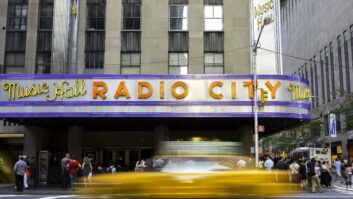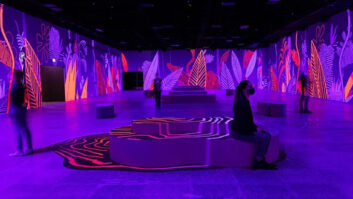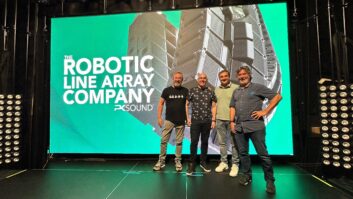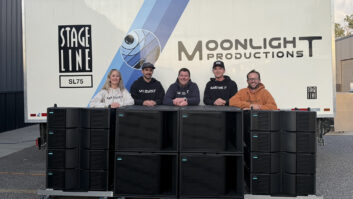Stadiums have always been a symbol, either of national identity, a particular sports club/team or a specific sport. Wembley Stadium, the Stade de France, the Aviva Stadium and Croke Park in the Republic of Ireland, the Olympiastadion in Berlin and Greece’s Olympic Stadium all embody the first category. Manchester United’s Old Trafford, Real Madrid’s Santiago Bernabéu Stadium, Wimbledon and Roland Garros, among many others [Aston Villa’s Villa Park!? – ed], fit into the second.
While the fundamental role of a stadium has not changed substantially over the years, the way venues are used and – most important of all – how they are designed, built and fitted out has developed considerably. They are now designed more with safety and ease of access in mind but it is the use of modern AV systems that is the most modernising change of all.
Sound systems have played a major role in entertaining and protecting fans over the last 30 years through PA (public address) and VA (voice alarm) systems but it is possibly on the visual side that has seen the bigger advances. Large-scale video screens have long been used to give a closer view of what is going on, particularly when music concerts are staged in massive stadiums [Foo Fighters at Villa Park in 2024! –ed], but screen technology is now all around modern venues, for entertainment, information, advertising and menus at the concession stands.
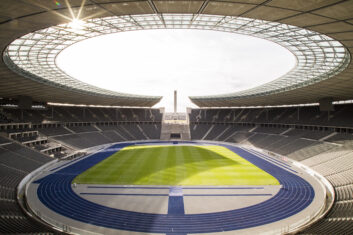 At one time these different displays would have been standalone systems but that has changed dramatically, with, as Mark Taylor, head of LED for European display organisation at Samsung, observes, stadium owners and operators now demanding a more centralised and connected approach. “It’s not just the large screens that sports stadiums are looking for when it comes to display and signage solutions,” he says. “They want suitable technology – including typically ‘in-house’ TV set-ups – that can be deployed and used through stadiums to enhance and optimise fan experience and engagement from the moment they enter to the moment they leave.”
At one time these different displays would have been standalone systems but that has changed dramatically, with, as Mark Taylor, head of LED for European display organisation at Samsung, observes, stadium owners and operators now demanding a more centralised and connected approach. “It’s not just the large screens that sports stadiums are looking for when it comes to display and signage solutions,” he says. “They want suitable technology – including typically ‘in-house’ TV set-ups – that can be deployed and used through stadiums to enhance and optimise fan experience and engagement from the moment they enter to the moment they leave.”
As an example of this Taylor cites the Swiss Life Arena, an ice hockey and entertainment venue in the Altstetten district of Zurich, Switzerland. This features what he describes as “240 strategically located displays” that were installed to create a complete display system around the stadium, including smart Q-series signage in the sports bar and on the concourse.
“Smart signage helps stadiums deliver distinctive content to fans, which can both elevate brand image and create an improved fan experience,” he explains. “In some cases, in gift shops or food stands for example, these solutions also provide opportunities to generate sales.”
FIRST WAVE
The first wave of big screens for stadia came in the 1980s. Early examples were based on existing technology, such as Mitsubishi’s Diamond Vision, which employed the cathode ray tube, and Astro Vision from Panasonic using fluorescent discharge tubes. The big breakthrough and the name now most associated with this era of video walls was JumboTron, introduced by Sony in 1985. This used a large-scale display composed of microprocessor-based light bulbs, which the manufacturer branded as Trini-lite.
Today the dominant display technology is LED. A leading name in both the manufacture and installation of LED screens is ADI, which produces LED displays and signage for general coverage and pre-match entertainment in specific, designated ‘fan zones’.
“LED is and has always been the only viable technology for stadium big screens,” comments Claire Fitzgerald-Firth, head of client engagement at ADI. “Due to being in an outdoor environment, it requires high brightness levels, an appropriate IP rating and a modular build so it can be built to different sizes and shapes.”
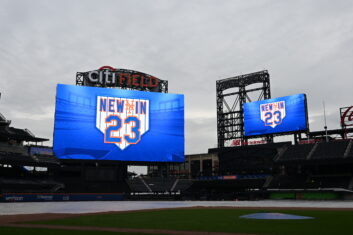 Fitzgerald-Firth adds that the technology has continued to evolve, enabling the manufacture of screens with not only higher resolutions but also greater energy efficiency and more lightweight construction. A recent project was as part of the upgrading of newly promoted Premier League side Burnley FC’s Turf Moor stadium. “Lighter, slimmer products require lighter supporting structures and this means more can be installed in more locations,” she explains. “Turf Moor is a notable example of this, with 1,100m² of our MT modules installed inside and outside the stadia bowl.”
Fitzgerald-Firth adds that the technology has continued to evolve, enabling the manufacture of screens with not only higher resolutions but also greater energy efficiency and more lightweight construction. A recent project was as part of the upgrading of newly promoted Premier League side Burnley FC’s Turf Moor stadium. “Lighter, slimmer products require lighter supporting structures and this means more can be installed in more locations,” she explains. “Turf Moor is a notable example of this, with 1,100m² of our MT modules installed inside and outside the stadia bowl.”
Burnley and another English club, Southampton, have both followed what Fitzgerald-Firth calls the current trend for wider screens and installed 32:9 super-wide displays. “This space creates a far more useful canvas for the stadium environment, allowing the live match broadcast to share the screen with additional information and promotional content simultaneously.”
MAJOR PLATFORM
In parallel to the big screens in the main stadium area, digital signage around the venue is now a major platform for carrying both information and advertising. “Digital signage is huge in stadia,” enthuses James Keen, vice president of marketing at Uniguest. “Even tier 2 and 3 teams tend to have between 100 and 200 displays, with larger venues and brands deploying thousands of end-points. Part of the driver is for providing enhanced value to sponsors and partners by improving their sponsor packages. Another factor is to drive improved event day sales, return on investment and improve engagement with the ticket holder.”
Starting out in the hotel and hospitality sector, Uniguest has broadened its operations to include stadiums, offering video walls, digital menu boards and wayfinding technologies among other displays. Keen observes that operators now expect all the different visual elements to be run from a single point, creating an integrated video system. “Stadia tend to want single platform control for all displays, delivering live event streams, advertising content, digital menus and ad-hoc moments of exclusive material from a single CMS,” Keen says.
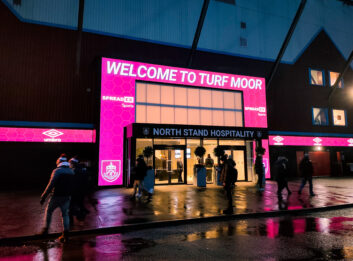
In these situations, he explains, the various platforms tend to either integrate with existing systems, such as electronic points of sale (PoS) for dynamic digital menus and broadcast and production systems for live game streams, which allows the digital signage and IPTV infrastructure to be largely passive and low maintenance on a game day. “Systems also need to cater to multiple occupants and brands, enabling the venue to instantly re-brand from a Premier League football set-up to NFL or a Bruce Springsteen concert in an instant, while also allowing pre-event configuration without impacting other event set-ups,” Keen adds.
Broadcast television coverage of sport is huge business today. While there is the option to take feeds from the main sports channels, many clubs now have their own in-house services that can produce and package footage to suit its target audience. As well as installing screen systems, ADI also builds on-site production facilities and provides tailored coverage over dedicated fibre circuits from its own control centre. “The live match is sent to ADI and mixed before being sent back to the stadium within a few hundredths of a second,” explains Fitzgerald-Firth. “We provide full programming, working closely with clubs to create a full stadium presentation for each home match.”
As eye-catching and all encompassing as video now is in stadiums, sound continues to play an important, dual role in modern venues. There is the long-established and necessary job of general announcements, with the vital and – one hopes – seldom if ever used VA system in case of emergencies.
The main PA also doubles as part of the overall entertainment, with the match day announcer or DJ building up the excitement with team information and music. This is usually blasted out at a high level, to the extent that radio and TV commentators often struggle to speak over it. The additional sound pressure capacity of modern systems is now necessary as a great many stadiums also stage concerts, with the in-house PA available to supplement touring rigs.
HIGH COSTS
This more general-purpose approach has, in many cases, been taken by clubs and operators to bring in more money and offset the high costs of running a modern stadium. An example of this is the Surprise Stadium in Arizona, USA, which is the spring training base for the Texas Rangers and Kansas City Royals baseball teams. In deciding to replace its old PA system, the stadium owners decided on a full audio upgrade, with the aim of also hosting corporate events, fundraisers and film nights. The venue now features an EAW AC6 ADAPTive column loudspeaker rig, which audio specialist Ben Davis says “seemed to fit all our needs”.
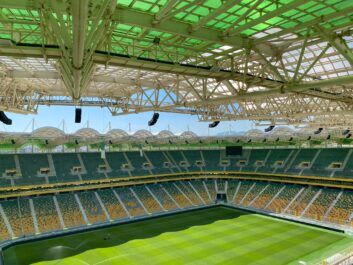 Stephen Hogg, managing director of d&b audiotechnik GB, observes that modern stadiums now have to be multi-purpose, enabling them to host a variety of sporting and entertainment events. “This requires a flexible, robust AV infrastructure that can inform, or entertain, whatever the situation,” he comments. “Sports venues are typically large installations and demand product reliability and comprehensive control and monitoring software to aid operators, alongside ease of integration to the existing infrastructure and interoperability with the media control systems.”
Stephen Hogg, managing director of d&b audiotechnik GB, observes that modern stadiums now have to be multi-purpose, enabling them to host a variety of sporting and entertainment events. “This requires a flexible, robust AV infrastructure that can inform, or entertain, whatever the situation,” he comments. “Sports venues are typically large installations and demand product reliability and comprehensive control and monitoring software to aid operators, alongside ease of integration to the existing infrastructure and interoperability with the media control systems.”
Among recent projects featuring d&b systems was the technical upgrade at Wembley Stadium. Hogg explains that although this was primarily undertaken for the Euro 2020 football tournament (held in 2021), the sports event sound system was designed to be rotated, retuned and made available to incoming live music productions, allowing the output to reach the upper tiers of the venue.
INCREASED POPULARITY
Ian Bridgewater, director and technical sales manager at TOA, comments that custom-built PA/VA systems have increased in popularity for the stadium market over the last few years. “They can be designed to scale up to meet the audio requirements of the venue and provide the option to operate with different loudspeakers, both indoor and [outside with] IP rated cabinets to withstand the elements,” he says.
“Allowing areas to work in zones gives the most flexibility to create the correct atmosphere, be it background music in retail and restaurant areas or delivering full pro audio music in the main arena. Scalability and flexibility are key and we are able to combine custom-built racks in our design with wall mount units, which are suitable for smaller areas that can then all link together.”
CUSTOMISED GROWTH
The growth in customisation is confirmed by Christian Glueck, senior product manager for electronics and software at Electro-Voice and Dynacord. “Stadia require different operator and user levels, with different functionalities to create the optimum workspace,” he says.
“This also means that users get exactly the function they require with fast, intuitive workflows that allow real-time manipulation. But the most important thing operators are looking for now is a one-stop solution, having everything centrally controlled. This means third-party integration has become particularly important and IP networked systems are vital for the effective running of modern stadia.”
Stadiums, while still embodying national or local sporting pride, are now expected to be so much more than a place where people play or watch football, athletics, rugby or tennis. They host concerts and other events but are, ultimately, places where people gather. AV now has a vital role in ensuring that they are informed, entertained and safe while they are there.


